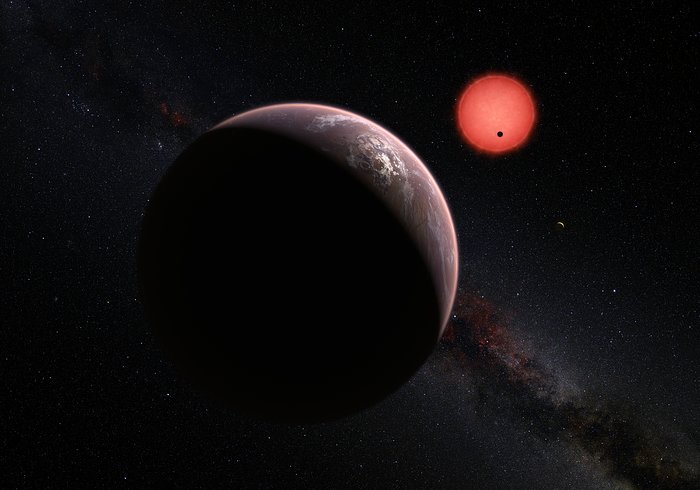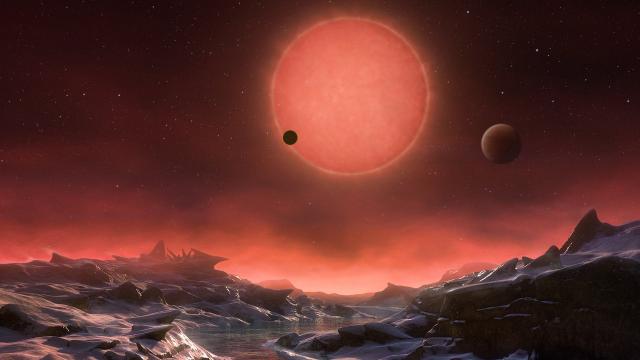In a few years, powerful new telescopes will usher in a search for habitable worlds outside our solar system. And TRAPPIST-1 — a dim, tepid star just a smidge larger than Jupiter — is one of the first places we’ll look. It’s only 40 light years away, and it’s home to several promising, Earth-sized exoplanets.
Three siblings, described today in the journal Nature, are the first exoplanets ever discovered around an “ultracool dwarf” star. And they’re a jackpot when it comes to the search for alien life. Each planet is similar in size to Earth or Venus and probably rocky. The planets all skirt the edge of the so-called habitable zone. Finally, these potential Earth twins are so close to us that we can begin studying their atmospheres right now.
“This is basically a paradigm shift,” study co-author Julien de Wit told Gizmodo. “If these planets have atmospheres, they really are the best places to look for life.”
So far, the search for exoplanets has focused on hot, bright stars, both because they are easy to spot in the sky and because we expect to find planets like Earth around stars like our own. But stars that are very cool and faint compared with the Sun are abundant throughout the galaxy. And when it comes to finding habitable worlds, these dim bulbs have one big advantage: their light doesn’t swamp out the signal of small, rocky planets.
“It is easier to study the atmospheres of exoplanets orbiting dim stars,” de Wit said, explaining that as a star gets smaller, a larger fraction of its light can pass through a planet’s atmosphere. What’s more, dim stars tend to be bright in the infrared, which is the best part of the spectrum for picking out key atmospheric features like water vapour and oxygen.
With this in mind, a team of astronomers led by the University of Liège’s Michaël Gillon put together a prototype telescope several years back to hunt for exoplanets around ultracool dwarfs, a group of dim objects teetering on the edge of starhood. Called TRAPPIST, the 0.6m scope sits at the La Silla Observatory in Chile, studying 60 nearby stars that can’t be seen with the naked eye. Like the Kepler Space Telescope, TRAPPIST searches for dips in infrared light — called transit events — that occur when a planet passes between its star and the Earth.
Now, after surveying just 15 of its 60 targets, the telescope has yielded a major discovery: three Earth-sized exoplanets orbiting a Jupiter-sized star 40 light years away in the constellation Aquarius. Dubbed “TRAPPIST-1”, the star is only eight per cent the mass of the Sun and 0.05 per cent as luminous.

Scaled comparison of the Sun and the ultracool dwarf star TRAPPIST-1, which is much smaller and redder. Image: ESO
Two of the system’s planets, TRAPPIST-1b and TRAPPIST-1c, are in very tight orbits, making a complete rotation around TRAPPIST-1 in less than three days. Although they’re orbiting at a distance much closer than Mercury, these planets only receive a little more sunlight than Venus. TRAPPIST-1d is in a wider orbit, receiving less sunlight than the Earth and perhaps even less than Mars.
We don’t yet know the masses of the planets, which makes it impossible to determine their composition. But based on their sizes and close orbits, de Wit says, we can be pretty sure they’re made of rock and ice.
TRAPPIST-1b and 1c are past the inner edge of the habitable zone where liquid water oceans can develop. TRAPPIST-1d, meanwhile, is teetering on the habitable zone’s outer rim. Nevertheless, portions of all three planets might be able to support life, thanks to a strange quirk of their orbit.
Unlike the Earth, which spins about its axis as it circles the Sun, planets in very close orbits become tidally locked — stuck in a particular orientation, with a permanent day side and a permanent night side. This is thought to be the case for the planets orbiting TRAPPIST-1. While the daysides of TRAPPIST-1b and 1c are too hot to support life as we know it, a twilight band between day and night may offer balmy temperatures and Earth-like weather.
TRAPPIST-1d’s exact orbit isn’t well constrained. If this planet receives as much solar energy as the Earth, the entire surface could be habitable. If it’s colder than Mars, the world may be covered in a thick sheet of ice. Even in the latter case, it’s possible TRAPPIST-1d has liquid water oceans and squirming life forms just beneath the surface.
“Life could still exist on a frozen planet, it would just be extremely hard to pick up remotely,” said Lisa Kaltenegger, an exoplanet research at Cornell University who was not involved with the study. “That’s the reason we have to fly to icy moons like Europa to see if there is life elsewhere in our solar system.”

Artist’s impression of planets orbiting TRAPPIST-1. Image: ESO/M. Kornmesser/N. Risinger
Travelling to the TRAPPIST-1 system is out of the question — but we may be able to pick up signatures of life from afar, by scouring the atmospheres of these planets for chemicals like carbon dioxide, water vapour and oxygen. When starlight passes through a planet’s atmosphere, different fractions are absorbed based on the molecules present, resulting in a distinct spectra. This spectra can reveal the planet’s atmospheric chemistry, including any signatures of life.
Peering into the skies of exoplanets to hunt for biosignatures is beyond state of the art — but not by much. The first telescope able to do so for nearby stars will be the James Webb, a 6.5m wide exoplanet hunting beast that blasts into orbit in 2018. Meanwhile, de Wit and his colleagues are getting a better look at the TRAPPIST-1 planets right now using the Hubble Space Telescope, which can determine if they have any atmospheres at all.
Even if none of the TRAPPIST-1 planets is habitable, the discovery of three Earth-sized worlds around an exotic star will help us round out our understanding of exoplanet diversity.
“It is exciting to fill in the gaps and learn what rocky planets would be like if they get more sunlight than Venus, or less than Mars,” Kaltenegger said.
Whatever we wind up finding around TRAPPIST-1, it’s clear we live in an incredibly exciting time when it comes to studying planets beyond our solar system — and that the biggest discoveries are still ahead of us.
Top: Artist’s impression of the view from the surface of a planet orbiting TRAPPIST-1. Image: ESO/M. Kornmesser
